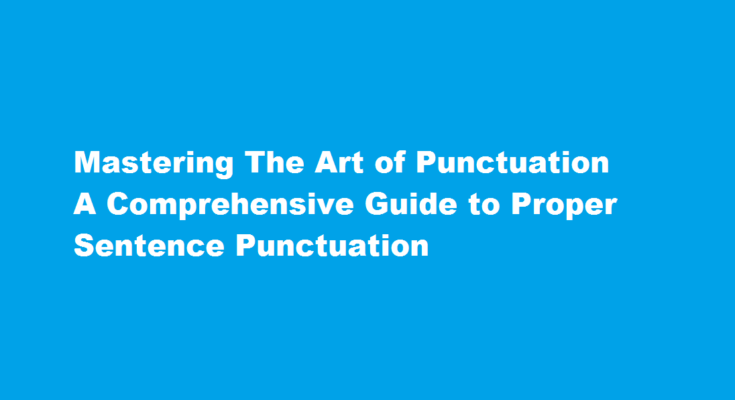Introduction
Effective punctuation is the cornerstone of clear and impactful writing. Properly punctuated sentences help convey meaning, enhance readability, and showcase your mastery of language. In this article, we will delve into the world of punctuation, exploring various punctuation marks and their specific functions. By the end, you will have a solid understanding of how to punctuate your sentences correctly, making your writing more engaging and professional.
The Period
Let’s start with the simplest punctuation mark—the period. A period is used to end a sentence that makes a complete thought. It indicates a full stop and separates one idea from another. While it may seem straightforward, using the period correctly is essential for clear communication. Remember to place one at the end of declarative statements, imperative sentences, and indirect questions that require a period.
The Comma
Commas are versatile punctuation marks that serve various purposes. They help separate items in a list, set off introductory phrases and clauses, and provide clarity in complex sentences. Use commas to separate coordinate adjectives, join independent clauses with coordinating conjunctions, and enclose non-essential information. Be cautious not to overuse commas, as this can lead to confusion. Understanding the different comma rules will enable you to punctuate your sentences accurately and create a smooth flow of ideas.
The Colon
When you want to introduce a list, explanation, or amplification, the colon is your punctuation mark of choice. It signals that what follows is directly related to the preceding statement. You can also use a colon to introduce a quotation, a summary, or a formal statement. Mastering the use of colons adds structure and emphasis to your writing, allowing you to present information in a clear and organized manner.
The Semicolon
The semicolon acts as a bridge between two related but independent clauses. It is used when a period would create a choppy effect, and a comma would not provide enough separation. Semicolons help maintain the flow of thought by linking closely related ideas. Be cautious not to overuse semicolons; they should be used sparingly and appropriately. Mastery of this punctuation mark adds sophistication and coherence to your writing.
The Question Mark
The question mark is an essential punctuation mark that signals a direct question. It is used at the end of an interrogative sentence to indicate a query or inquiry. When using question marks, ensure that the sentence structure aligns with the intended meaning. Remember to avoid using multiple question marks or combining a question mark with other punctuation marks, as it can create confusion and diminish the impact of your question.
The Exclamation Point
Exclamation points convey strong emotions, enthusiasm, or a sense of urgency. They add emphasis and indicate excitement, surprise, or strong statements. However, excessive use of exclamation points can dilute their impact. Reserve them for situations that genuinely warrant exclamation. Remember that the strength of your words should carry the message, and the exclamation point should serve as a complement rather than a crutch.
FREQUENTLY ASKED QUESTIONS
What are the 12 marks of punctuation?
They are the period, questionmark, exclamation point, comma, semicolon, colon, dash, hyphen, parentheses, brackets, braces, apostrophe, quotation marks, and ellipsis.
What is the concept of punctuation?
Punctuation, according to the Oxford Learner’s Dictionary, is defined as “the marks used in writing that divide sentences and phrases; the system of using these marks.” The Merriam-Webster Dictionary defines punctuation as “the act or practice of inserting standardized marks or signs in written matter to clarify the …
Conclusion
Punctuation is the key to unlocking the full potential of your writing. By mastering the proper use of punctuation marks such as periods, commas, colons, semicolons, question marks, and exclamation points, you can elevate your writing to new heights. Clear and accurate punctuation enhances comprehension, improves readability, and ensures your message resonates with your readers. With practice and attention to detail, you will master the art of punctuation and craft sentences that captivate and engage your audience.
Read Also : Mastering The Art of Punching in Stumble Guys A Guide to Victory



